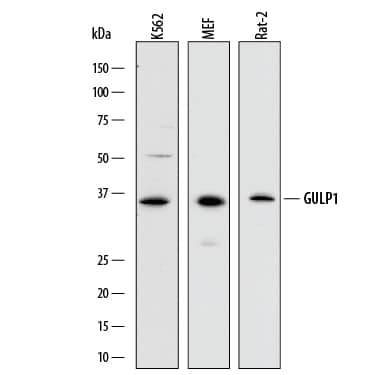Human/Mouse/Rat GULP1/CED-6 Antibody
R&D Systems, part of Bio-Techne | Catalog # AF7978

Key Product Details
Species Reactivity
Applications
Label
Antibody Source
Product Specifications
Immunogen
Met1-Asn92
Accession # Q9UBP9
Specificity
Clonality
Host
Isotype
Scientific Data Images for Human/Mouse/Rat GULP1/CED-6 Antibody
Detection of Human, Mouse, and Rat GULP1/CED-6 by Western Blot.
Western blot shows lysates of K562 human chronic myelogenous leukemia cell line, MEF mouse embryonic feeder cells, and Rat-2 rat embryonic fibroblast cell line. PVDF membrane was probed with 1 µg/mL of Sheep Anti-Human/Mouse/Rat GULP1/CED-6 Antigen Affinity-purified Polyclonal Antibody (Catalog # AF7978) followed by HRP-conjugated Anti-Sheep IgG Secondary Antibody (Catalog # HAF016). A specific band was detected for GULP1/CED-6 at approximately 36 kDa (as indicated). This experiment was conducted under reducing conditions and using Immunoblot Buffer Group 1.Applications for Human/Mouse/Rat GULP1/CED-6 Antibody
Western Blot
Sample: K562 human chronic myelogenous leukemia cell line, MEF mouse embryonic feeder cells, and Rat‑2 rat embryonic fibroblast cell line
Formulation, Preparation, and Storage
Purification
Reconstitution
Formulation
Shipping
Stability & Storage
- 12 months from date of receipt, -20 to -70 °C as supplied.
- 1 month, 2 to 8 °C under sterile conditions after reconstitution.
- 6 months, -20 to -70 °C under sterile conditions after reconstitution.
Background: GULP1/CED-6
GULP1 (also PTB domain-containing engulfment adaptor protein 1 and Cell death protein 6 homolog/CED6) is a 36-40 kDa, cytosolic member of the ced-6 family of proteins. It is expressed by multiple cell types, including macrophages, neurons and sinusoidal endothelial cells, and is believed to play a key role in phaogcytosis, particularly involving apoptotic cells. Failure to remove apoptotic cells is suggested to contribute to chronic inflammatory conditions. GULP1 is involved with a MEGF10:GULF:stabilin-1:stabilin-2 internalization pathway. Possibly following endosome formation, it binds to transmembrane activated stabilins and/or LRP1 as a homodimer, and serves as an intermediate for signal transduction. GULP1 also binds to APP, facilitating its proteolysis and the generation of A beta. Human GULP1 is 304 amino acids (aa) in length. It contains one PTB domain (aa 17-154) that interacts with transmembrane receptors, a Leu-zipper (aa 163-193) that mediates dimerization, and a Pro-rich region (aa 238-271) that is likely involved with signal transduction. There are three splice variants. One shows a deletion of aa 31-133, a second contains a 34 aa substitution for aa 134-304, and a third contains a 10 aa substitution for aa 282-304. Over aa 1-92, human GULP1 shares 99% aa sequence identity with mouse GULP1.
Alternate Names
Gene Symbol
UniProt
Additional GULP1/CED-6 Products
Product Documents for Human/Mouse/Rat GULP1/CED-6 Antibody
Product Specific Notices for Human/Mouse/Rat GULP1/CED-6 Antibody
For research use only
